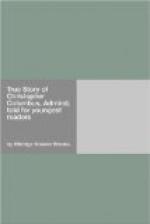When they sailed from the Canaries a reward had been offered to whomsoever should first see land. This reward was to be a silken jacket and nearly five hundred dollars in money; so all the sailors were on the watch.
At about ten o’clock on the evening of the eleventh of October, Columbus, standing on the high raised stern of the Santa Maria, saw a moving light, as if some one on the shore were running with a flaming torch. At two o’clock the next morning—Friday, the twelfth of October, 1492 the sharp eyes of a watchful sailor on the Pinta (his name was Rodrigo de Triana) caught sight of a long low coastline not far away. He raised the joyful shout Land, ho! The ships ran in as near to the shore as they dared, and just ten weeks after the anchors had been hauled up in Palos Harbor they were dropped overboard, and the hips of Columbus were anchored in the waters of a new world.
Where was it? What was it? Was it Cathay? Columbus was sure that it was. He was certain that the morning sun would shine for him upon the marble towers and golden roofs of the wonderful city of the kings of Cathay.
CHAPTER VI. WHAT COLUMBUS DISCOVERED.
A little over three hundred years ago there was a Pope of Rome whose name was Gregory XIII. He was greatly interested in learning and science, and when the scholars and wise men of his day showed him that a mistake in reckoning time had long before been made he set about to make it right. At that time the Pope of Rome had great influence with the kings and queens of Europe, and whatever he wished them to do they generally did.
So they all agreed to his plan of renumbering the days of the year, and a new reckoning of time was made upon the rule that most of you know by heart in the old rhyme:
Thirty days hath September, April, June and November; All the rest have thirty-one, Excepting February which alone Hath twenty-eight—and this, in fine, One year in four hath twenty-nine.
And the order of the days of the months and the year is what is called, after Pope Gregory, the Gregorian Calendar.
This change in reckoning time made, of course, all past dates wrong. The old dates, which were called Old Style, had to be made to correspond with the new dates which were called New Style.
Now, according to the Old Style, Columbus discovered the islands he thought to be the Indies (and which have ever since been called the West Indies) on the twelfth of October, 1492. But, according to the New Style, adopted nearly one hundred years after his discovery, the right date would be the twenty-first of October. And this is why, in the Columbian memorial year of 1892, the world celebrated the four hundredth anniversary of the discovery of America on the twenty-first of October; which, as you see, is the same as the twelfth under the Old Style of reckoning time.
But did Columbus discover America? What was this land that greeted his eyes as the daylight came on that Friday morning, and he saw the low green shores that lay ahead of his caravels.




